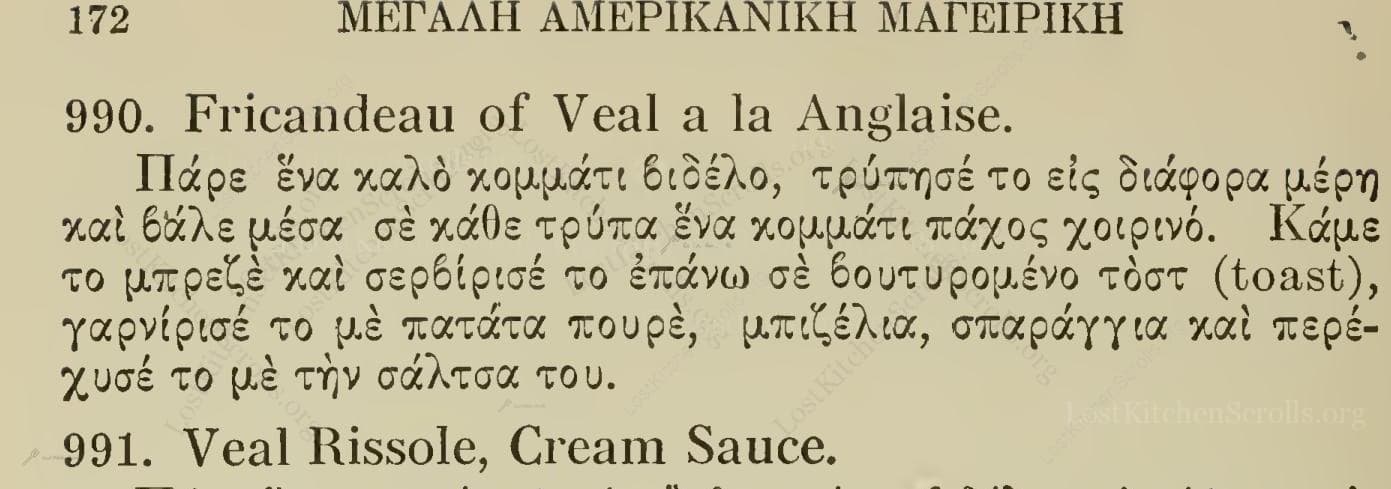Fricandeau Of Veal A La Anglaise
"Fricandeau Of Veal À La Anglaise"
From the treasured pages of Megale amerikanike mageirike dia mageirous kai oikogeneias
Written by Michael Gkines

Fricandeau Of Veal A La Anglaise
"Πάρε ἕνα καλὸ κομμάτι βιδέλο, τρύπησέ το εἰς διάφορα μέρη καὶ βάλε μέσα σὲ κάθε τρύπα ἕνα κομμάτι πάχος χοιρινό. Κάμε το μπρεζὲ καὶ σερβίρισέ το ἐπάνω σὲ βουτυρομένο τὀστ (toast), γαρνίρισέ το μὲ πατάτα πουρέ, μπιζέλια, σπαράγγια καὶ περιέχυσέ το μὲ τὴν σάλτσα του."
English Translation
"Take a good piece of veal, pierce it in several places and insert a piece of pork fat into each hole. Braise it and serve it on buttered toast, garnish with mashed potatoes, peas, asparagus, and pour its sauce over it."
Note on the Original Text
The recipe text is concise, assuming a cook's familiarity with processes like 'larding' (inserting pork fat into the meat) and 'braising.' The language is direct, often in the imperative mood, and omits detailed timings or temperatures—reflecting both the oral kitchen culture of the time and the practical limitations of early 20th-century home kitchens. Spellings and terminology (e.g., 'μπρεζέ' for braise, 'βιδέλο' for veal) are Hellenized transcriptions of French culinary terms. The recipe is structured for flexibility, expecting the cook to rely on experience for seasoning and degree of doneness.

Title
Megale amerikanike mageirike dia mageirous kai oikogeneias (1917)
You can also click the book image above to peruse the original tome
Writer
Michael Gkines
Era
1917
Publisher
Ekdotika Katastemata
Background
A sumptuous journey through early 20th-century Greek-American kitchens, this cookbook offers practical and time-tested recipes for savory dishes and delightful sweets—each crafted to suit the American system, yet infused with Greek tradition. A perfect companion for both family cooks and aspiring chefs.
Kindly made available by
Internet Archive
This recipe hails from Michael Gkines’s 'Megale amerikanike mageirike dia mageirous kai oikogeneias', published in New York in 1917. The book reflects the lively Greek immigrant community in America, blending Old World flavors with New World ingredients and culinary influences. This 'Fricandeau of Veal à la Anglaise' adapts a classic French dish for a Greek-speaking readership embracing modern American techniques. The choice of 'à la Anglaise' (English-style) and the inclusion of buttered toast as a serving base captures a cosmopolitan approach, marrying French, English, and American traditions on one plate.

A sharp paring or boning knife was essential for larding the veal with pork fat. Braising required a heavy pot or Dutch oven—often enamel or copper—in which the meat would be browned, then covered and cooked gently on a stove or hearth. Toast was made by grilling or toasting bread over an open flame or in an oven, then spreading with butter. A ricer or masher was used for the potato purée, while saucepans and strainers helped with the vegetables and sauce.
Prep Time
30 mins
Cook Time
2 hrs
Servings
6
We've done our best to adapt this historical recipe for modern kitchens, but some details may still need refinement. We warmly welcome feedback from fellow cooks and culinary historians — your insights support the entire community!
Ingredients
- 2.2–3.3 lb veal roast (ideally from the leg or round)
- 2–3 oz pork fat (back fat or salt pork; can substitute with thick-cut bacon in a pinch)
- Salt and pepper, to taste
- 2 tbsp butter (for browning and toast)
- 2 cups veal or beef stock (for braising)
- 4–6 slices crusty bread (about 3/4 inch thick)
- 1.1 lb potatoes (for mash)
- 3/4 cup milk (for mash)
- 1–2 tbsp butter (for mash)
- 7 oz green peas
- 6–8 asparagus spears
- Optional: additional herbs (thyme, bay leaf) for braising
Instructions
- Begin by selecting a good-sized piece of veal, around 2.2–3.3 lb.
- With a sharp knife, make multiple small incisions across the surface of the meat.
- Into each incision, insert a small strip of pork fat or lard (about 2–3 oz total).
- Next, braise the veal gently: sear it to brown, then cover and slowly cook it in a flavorful broth or stock for about 1.5–2 hours, until tender.
- Once done, slice and arrange the veal on slices of buttered toast (use 4–6 slices of sturdy bread brushed with melted butter).
- Serve it decorated with creamy mashed potatoes (approximately 1.1 lb), tender green peas (7 oz), and a handful of steamed asparagus spears (6–8).
- Finally, spoon the rich braising juices or sauce over the platter before serving.
Estimated Calories
600 per serving
Cooking Estimates
You'll spend about 30 minutes preparing the meat and sides, then let the veal cook gently for 1.5 to 2 hours. Each serving has about 600 calories. This recipe makes 6 servings.
As noted above, we have made our best effort to translate and adapt this historical recipe for modern kitchens, taking into account ingredients nowadays, cooking techniques, measurements, and so on. However, historical recipes often contain assumptions that require interpretation.
We'd love for anyone to help improve these adaptations. Community contributions are highly welcome. If you have suggestions, corrections, or cooking tips based on your experience with this recipe, please share them below.
Join the Discussion
Rate This Recipe
Dietary Preference
Main Ingredients
Occasions

Den Bockfisch In Einer Fleisch Suppen Zu Kochen
This recipe hails from a German manuscript cookbook compiled in 1696, a time whe...

Die Grieß Nudlen Zumachen
This recipe comes from a rather mysterious manuscript cookbook, penned anonymous...

Ein Boudain
This recipe comes from an anonymous German-language manuscript cookbook from 169...

Ein Gesaltzen Citroni
This recipe, dating from 1696, comes from an extensive anonymous German cookbook...
Browse our complete collection of time-honored recipes



